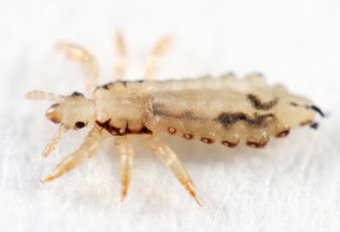District implements new head lice procedures
Information posted on district policies & effective treatment
HEAD LICE (PEDICULOSIS)
We are beginning to find students with head lice. This is an increasing problem throughout the country. For your family’s protection and to prevent spreading lice to others, it is recommended that parents check their children about once a week.
WHO GETS LICE? Anyone. Frequent, regular shampooing does not prevent lice. Younger children seem to catch them more frequently because of more close contact with one another. Animals do not carry or contact head lice.
HOW DO YOU GET THEM? They walk. They do not fly or hop. They travel from person to person directly (two heads touching) or are transferred via personal articles (combs, brushes, hats, pillowcases, etc.).
FACTS ABOUT LICE: The adult louse is a wingless insect less that 1/8” long and is a pale brownish-gray. Lice do not carry disease. They bite the scalp causing itching. They move quickly and avoid light so they are often difficult to see. The female louse lays 3-6 eggs (nits) per day and may live up to 30 days. The nits (egg sacs) of lice appear to be cemented to human hair. The nits appear as small, silvery oval-shaped specks that look like dandruff. They are difficult to remove. The nits hatch in 7-10 days.
WHAT TO DO IF YOUR CHILD COMES HOME WITH HEAD LICE
Don’t panic. Don’t blame. Anyone—adult or youngster—can get head lice. Head lice are passed from person to person by direct contact or on shared objects. It has nothing to do with cleanliness and does not reflect on you as a parent. Follow the directions below to manage head lice and nits:
- Check every member of the family. Look for tiny silvery egg sacs (nits) in hair shafts, near the scalp, especially at the nape of the neck and behind the ears. Head lice are small brownish-gray insects without wings. Any family member with lice or nits must be treated.
- Head lice treatment. There are several head lice remedies. You can purchase these products at your local pharmacy, by prescription, or over the counter. Follow the directions on the products insert.
- Although it can take time and sometimes be difficult, removal of all nits will insure complete treatment. Head lice products do not kill all the nits and survivors will hatch into crawling lice with 7-10 days, generating a cycle of reinfestation. Nit removal can be accomplished with a special metal/plastic combing tool manufactured for this purpose. Nit combing is best accomplished with hair which is dry or slightly damp. Discard nits into a plastic bag and seal for disposal.
- The best way to remove all nits is to manually pull the nit from the hair shaft and dispose of it.
- A daily nit check is advised for at least 10 days following treatment and then should become part of routine home hygiene. You may have to retreat in 7-10 days if there is evidence of new nits or newly hatched lice.
TREATMENT OF PERSONAL ARTICLES AND ENVIRONMENT
- Machine wash all clothing and bed linens which have been in contact with the infested person. Use hot water and dry in a hot dryer. Non-washable items such as stuffed animals, sleeping bags, headphones, and helmets should be stored in tightly sealed plastic bags at room temperature for two weeks.
- Vacuum everywhere. Rugs, upholstered furniture and mattresses, even car seats should be carefully vacuumed to pick up any living lice or nits attached to fallen hairs. Discard vacuum bag into sealed plastic bag for disposal. The use of insecticidal sprays is not recommended and strongly discouraged as it may be harmful to family member and is of questionable benefit.
- Soak combs, brushes, etc. in hot water for 5-10 minutes. Also soak hair barrettes, ribbons, head bands, etc.
REPORTING CASES
Don’t be embarrassed to notify your child’s school so school staff can be alerted to a possible outbreak. Parental cooperation will help protect all children including your own.
If you have any questions, please contact WPS Nurse Josh Trutna at (402) 443-4250, or email jtrutna@esu2.org.


 Launch the media gallery 1 player
Launch the media gallery 1 player